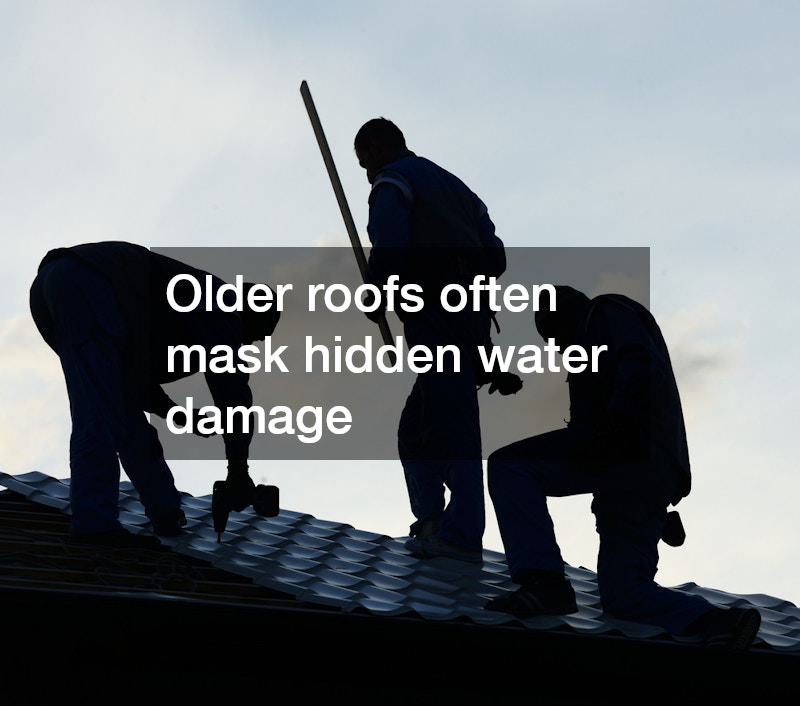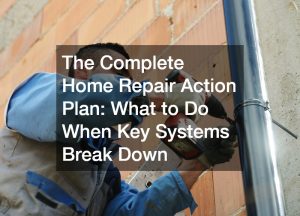Buying an old home can be both exciting and intimidating. These properties often come with unique character, charming details, and craftsmanship that newer builds sometimes lack. Yet behind the allure, many older homes hide a range of repair and maintenance needs that, if ignored, can quickly lead to expensive surprises.
The key to turning a vintage house into a comfortable, functional home lies in strategic pre-purchase renovation planning. By understanding what systems to inspect, upgrade, or replace before moving in, you can avoid emergencies, preserve the home’s integrity, and make informed investment decisions.
Start with Plumbing and Drainage System Evaluations
Plumbing issues are among the most common—and costly—problems found in older homes. Pipes may be corroded, fixtures outdated, or drainage systems improperly sloped. Addressing these before closing the deal ensures you’re not walking into hidden water damage or ongoing leaks.
The best place to begin is with a professional inspection from a licensed plumber. This expert can identify outdated materials like galvanized steel or lead piping that may need replacement. They’ll also assess water pressure, look for slow drains, and check for any hidden leaks behind walls or under floors.
A comprehensive inspection often includes evaluating the water heater, sewage connections, and sump pump systems if applicable. In older homes, these components are often near the end of their lifespan and may need upgrading for efficiency and safety.
Beyond interior plumbing, proper drainage around the home is critical for protecting your foundation. If the yard slopes toward the house or you notice standing water near the basement, installing or upgrading a french drain can help divert excess moisture away from the property.
Before buying, make sure to:
-
Request a plumbing inspection report with recommendations for upgrades or replacements.
-
Factor plumbing repairs into your renovation budget early.
-
Consider having the sewer line scoped with a camera for any blockages or cracks.
-
Ask your inspector about water pressure and fixture efficiency for potential savings.
A sound plumbing and drainage system is the backbone of a safe, dry, and livable home.

Conduct a Full Roof and Attic Assessment
The roof serves as your home’s first line of defense against the elements—and in an old property, it’s often one of the most vulnerable components. Over the years, exposure to sun, rain, and temperature shifts can weaken materials and cause subtle damage that isn’t always visible from the ground. Even a small leak can gradually compromise insulation, ceilings, and structural framing, leading to costly repairs later. Before committing to a purchase, a thorough inspection of both the roof and attic is essential to ensure the home’s integrity and long-term performance.
To get a complete and accurate evaluation, hire a roofing contractor that does inspections. The contractor can focuses on immediate surface concerns—such as cracked, curled, or missing shingles—and provide a deeper analysis, evaluating structural support, ventilation balance, and insulation effectiveness. This gives you a complete picture of your roof’s true condition. It also helps you determine whether the structure requires only minor maintenance or a complete replacement in the near future.
A professional roof inspection should extend beyond the shingles and tiles. The attic, often overlooked, plays a crucial role in maintaining a healthy and efficient roof system. Poor ventilation in the attic can trap heat and moisture, accelerating material decay and promoting mold growth. Similarly, outdated or insufficient insulation can lead to uneven indoor temperatures and inflated energy bills. Addressing these underlying issues early not only protects your investment but also improves comfort and efficiency once you move in.
When reviewing your roof’s condition, pay attention to:
-
Water infiltration: Look for stains, dark streaks, or soft spots on attic surfaces—these often signal hidden leaks.
-
Damaged or missing shingles: Curling, brittle, or missing shingles suggest weathering or poor maintenance over time.
-
Flashing and sealant condition: Inspect around chimneys, vents, and skylights for rusted or loose flashing that could allow water entry.
-
Ventilation balance: Ensure there’s sufficient airflow through soffits, ridge vents, or gables to prevent heat and moisture buildup.
-
Insulation quality: Evaluate whether existing insulation meets current energy standards or needs to be replaced.
It’s also wise to ask your roofing expert for photos and detailed documentation of any issues uncovered. A comprehensive inspection report, complete with repair or replacement estimates, can strengthen your negotiating position with the seller. In some cases, you might be able to request a repair credit or adjust the purchase price based on the roof’s condition.
If significant repairs are needed, consider having the roofing expert recommend modern materials and installation methods that improve durability and efficiency. For instance, updated underlayment products and proper attic sealing techniques can enhance protection against moisture and heat loss. These upgrades, while sometimes adding upfront cost, can dramatically extend the roof’s lifespan and lower energy expenses in the long run.
Ultimately, a meticulous roof and attic assessment does more than just prevent leaks—it protects the entire structure beneath it. Ensuring that your roofing system is sound provides peace of mind and lays a strong foundation for every other renovation you plan to undertake.
Protecting the Foundation and Basement from Moisture
Basement moisture is one of the most overlooked yet damaging problems in older homes. Persistent dampness, cracks, or efflorescence (white, chalky residue) are red flags that signal potential foundation or drainage issues.
Hiring a qualified waterproofing contractor before purchasing gives you an accurate picture of how well the basement or crawl space is protected. They can assess for leaks, recommend sealants, and identify any grading or gutter problems contributing to water intrusion.
One of the most effective moisture prevention methods is a properly installed french drain. This underground system redirects water away from the foundation, reducing the risk of flooding and mold growth.
Additional steps to protect your basement include:
-
Applying waterproof coatings to walls and floors.
-
Installing or servicing sump pumps.
-
Extending downspouts and ensuring proper yard grading.
-
Maintaining clean gutters and functional drainage channels.
Combining waterproofing solutions with proactive maintenance ensures your foundation remains strong and dry for years to come.
Evaluating Heating and Cooling Systems Before You Move In
Heating and cooling systems in older homes often operate inefficiently or rely on outdated components. Without proper inspection, you may face high energy bills or even system failure soon after moving in.
Professional evaluation by ac repair companies can reveal whether your HVAC system needs servicing, replacement, or efficiency upgrades. These technicians can test duct integrity, refrigerant levels, and thermostat accuracy. A well-functioning HVAC system is not only about comfort—it’s about maintaining indoor air quality and preventing moisture or mold buildup.
The condition of your roof also plays a role in HVAC performance. Poor insulation or leaks can cause heat loss in winter and increased cooling demands in summer. Collaborate with your roofing contractor to ensure attic insulation supports HVAC efficiency.
To prepare your system for optimal operation:
-
Schedule an HVAC inspection before closing.
-
Replace old filters and clean air ducts for better airflow.
-
Install a programmable thermostat for energy savings.
-
Discuss long-term maintenance plans with service providers.
A reliable HVAC setup ensures your new home stays comfortable, healthy, and cost-efficient throughout the year.
Planning Functional and Aesthetic Interior Updates
Once the core systems are assessed, focus on improving livability and design. Many old homes need modern upgrades that blend functionality with historic charm—starting with the kitchen and bathrooms.
A bath remodel can enhance comfort and efficiency by replacing outdated fixtures with water-saving models and improved lighting. Consider updating plumbing fixtures during the remodel to prevent future issues. Accessible features like walk-in showers or grab bars can add both safety and long-term value.
For kitchens, durable and stylish kitchen countertops can dramatically transform the space. Granite, quartz, and solid-surface materials offer excellent durability while maintaining a timeless look that complements classic architecture.
Renovation planning tips:
-
Tackle plumbing and electrical updates before cosmetic finishes.
-
Choose neutral materials that align with the home’s age and character.
-
Budget for quality materials that withstand daily use.
-
Focus on long-term functionality—storage, lighting, and ease of maintenance.
Thoughtful upgrades create modern comfort while preserving the distinctive feel that makes older homes special.
Inspecting Pools and Outdoor Amenities for Safety
If the property includes a pool or spa, it’s essential to inspect these features before purchase. Older pools may have structural cracks, outdated filtration, or unsafe electrical components that require costly repairs.
Start with professional testing of the pool’s systems, including pumps, filters, and plumbing. Maintaining safe and balanced water quality relies heavily on efficient pool ph control systems. These systems automatically regulate chemical levels, keeping water clear and safe for use.
Consulting with a waterproofing contractor can also help assess surrounding pool decks, patios, or retaining walls for cracks or moisture infiltration. These areas, if neglected, can affect nearby structures or foundations.
Key safety and maintenance considerations:
-
Inspect electrical systems connected to lighting or heating elements.
-
Ensure fencing and gates meet local safety regulations.
-
Confirm that drainage directs water away from the home’s foundation.
-
Upgrade to automated pool systems for convenience during long absences.
Taking preventive steps before purchase ensures your outdoor amenities are safe, enjoyable, and easy to maintain.
Upgrading for Safety, Efficiency, and Storm Protection
Many older homes were not built with modern weather challenges in mind. Upgrading structural elements can dramatically improve safety, energy efficiency, and peace of mind.
Installing impact windows and doors provides superior protection against storms, break-ins, and heat loss. These durable fixtures also block UV rays and reduce noise, making the home more comfortable. In areas prone to hurricanes or strong winds, these upgrades are particularly valuable.
Partnering with a roofing expert ensures your roof, windows, and doors work together as part of a comprehensive weatherproofing system. Proper sealing, insulation, and installation techniques can significantly improve performance and longevity.
Actionable upgrade recommendations:
-
Seek products with certified energy ratings and wind resistance.
-
Review manufacturer warranties and local rebate options.
-
Combine exterior improvements with insulation upgrades for maximum results.
-
Schedule periodic inspections after extreme weather events.
A reinforced building envelope not only improves safety but also contributes to long-term cost savings on energy and maintenance.
Setting a Realistic Renovation Budget and Timeline
Renovating an older home is an exciting opportunity to blend charm with modern functionality—but it also demands careful financial planning and disciplined scheduling. Without a structured budget and timeline, unexpected expenses and delays can spiral out of control. Older properties often conceal problems such as outdated wiring, hidden water damage, or inefficient HVAC systems, which can significantly affect your overall renovation costs.
To begin, prioritize repairs and upgrades that protect the home’s integrity and livability before moving to purely cosmetic projects. Essential updates—like a bath remodel, structural reinforcements, or energy-efficient system upgrades—should take precedence over design elements. When developing your plan, consider dividing the renovation into phases based on urgency and available funds. This ensures progress continues without financial strain.
Engaging with trusted contractors early in the process helps set realistic expectations. For instance, AC repair companies can inspect aging cooling systems and provide detailed estimates for servicing or replacements, which can help you avoid future breakdowns. Similarly, other specialists can provide insight into the scope of work for plumbing, roofing, or electrical systems. Gathering multiple estimates from licensed professionals not only helps you benchmark fair pricing but also protects you from hidden fees or inflated costs.
Budgeting best practices:
-
Begin by creating a master checklist of all desired renovations, then categorize them as urgent, necessary, or optional to determine where your funds will have the most impact.
-
Add a contingency reserve of at least 10–20% to accommodate unforeseen issues such as leaks, insulation problems, or pest damage.
-
Track every expense digitally using budgeting apps or spreadsheets to maintain a clear overview of costs.
-
Request itemized quotes from every contractor to ensure transparency on materials, labor, and potential add-ons.
-
Schedule major projects—like HVAC maintenance or roof work—during off-peak seasons when rates are often lower and contractors are more available.
-
Maintain open communication with contractors about progress and potential delays so you can adjust timelines proactively.
It’s also helpful to factor in how renovation phases overlap. For example, if your bath remodel involves plumbing reroutes, coordinate with your HVAC and electrical teams to avoid redundant demolition or rework. The same applies when managing multiple updates—synchronizing tasks between contractors saves both time and money.
Finally, revisit your budget periodically throughout the renovation process. As unexpected issues arise, your priorities may shift, requiring reallocation of funds. With clear planning, strategic scheduling, and careful expense management, you’ll transform your old house efficiently while keeping costs under control and your stress level low.
Purchasing an older home can be a deeply rewarding experience, offering both character and the opportunity to customize your space for modern living. But to truly enjoy your investment, it’s crucial to plan ahead—assessing core systems, evaluating safety features, and setting realistic renovation priorities.
By working closely with skilled professionals, from plumbers and roofers to contractors and energy specialists, you can preserve the charm of your old home while upgrading it for long-term comfort and efficiency. With thoughtful preparation, an aging house can become a secure, beautiful home for decades to come.









